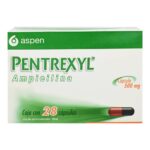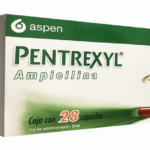Can You Take Pentrexyl For Urinary Tract Infection (UTI)?

What is a urinary tract infection (UTI)?
A urinary tract infection (UTI) is an infection of the urinary system. This type of infection can involve your urethra (a condition called urethritis), kidneys (a condition called pyelonephritis) or bladder, (a condition called cystitis).Your urine typically doesn’t contain bacteria (germs). Urine is a byproduct of our filtration system—the kidneys. When waste products and excess water is removed from your blood by the kidneys, urine is created. Normally, urine moves through your urinary system without any contamination.
However, bacteria can get into the urinary system from outside of the body, causing problems like infection and inflammation. This is a urinary tract infection (UTI).
What is the urinary tract?
The urinary tract makes and stores urine, one of the body’s liquid waste products. The urinary tract includes the following parts:
Kidneys: These small organs are located at the back of your body, just above the hips. They are the filters of your body — removing waste and water from your blood. This waste becomes urine.
Ureters: The ureters are thin tubes that carry urine from the kidneys to your bladder.
Bladder: A sac-like container, the bladder stores your urine before it leaves the body.
Urethra: This tube carries the urine from your bladder to the outside of the body.
How common are urinary tract infections (UTIs)?
Urinary tract infections are very common, occurring in 1 out of 5 women sometime in their lifetime. Though UTIs are common in women, they can also happen to men, older adults and children. One to 2% of children develop urinary tract infections. Each year, 8 million to 10 million visits to doctors are for urinary tract infections.
Who gets urinary tract infections (UTIs)?
Anyone can get a urinary tract infection, but they are more common in women. This is because the urethra (tube that carries urine out of the body) in females is shorter and closer to the anus, where E. coli bacteria are common. Older adults also are at higher risk for developing cystitis. This increased risk may be due to incomplete emptying of the bladder. There are several medical conditions that can be related to this, including an enlarged prostate or a bladder prolapse (a condition where the bladder falls or slips out of its usual position).
If you get frequent urinary tract infections, your healthcare provider may do tests to check for other health problems such as diabetes or an abnormal urinary system that may be contributing to your infections. People with frequent UTIs are occasionally given low-dose antibiotics for a period of time to prevent the infection from coming back. This cautious approach to treating frequent UTIs is because your body can develop a resistance to the antibiotic and you can get other types of infections, such as C. diff colitis. This practice is used very infrequently.
What is Pentrexyl?
Pentrexyl is a brand of ampicillin in Mexico, Ecuador, Kuwait, Lebanon , Serbia and several other countries. Pentrexyl ampicillin is an antibiotic used to prevent and treat a number of bacterial infections, such as respiratory tract infections, urinary tract infections, meningitis, salmonellosis, and endocarditis. It may also be used to prevent group B streptococcal infection in newborns.
Pentrexyl belongs to the drug class penicillins. A class of drugs is a group of medications that work in a similar way. These drugs are often used to treat similar conditions. It works by killing bacteria to stop the infection from growing in your body. Pentrexyl oral capsule is a prescription drug, it also comes as an oral suspension and in an intravenous (IV) form, which is only given by a healthcare provider.
Does Pentrexyl Work For Urinary Tract Infection (UTI)?
Yes, Pentrexyl works well for the treatment of UTI’s. It is also used to treat certain infections that are caused by bacteria such as meningitis (infection of the membranes that surround the brain and spinal cord); and infections of the throat, sinuses, lungs, reproductive organs, and gastrointestinal tract.
Why is amoxicillin preferred over Pentrexyl?
The in vitro activity of amoxicillin is similar to that of ampicillin. Amoxicillin is the preferred oral agent because it is less likely to cause diarrhea and can be administered less frequently than oral Pentrexyl.
How Do You Take Pentrexyl?
The usual oral dose of Pentrexyl 500mg for most infections is 500 mg 4 times daily for 7-14 days. Food in the stomach reduces how much and how quickly ampicillin is absorbed. Therefore, Pentrexyl 500mg should be taken either 1 hour prior to or 2 hours following a meal for maximal absorption; however, for persons who experience nausea or stomach distress after taking Pentrexyl 500mg, it may be taken with meals.
Is Pentrexyl 500mg safe to use during pregnancy or while breastfeeding?
Pentrexyl 500mg is considered safe during pregnancy. Ampicillin is excreted in breast milk and may cause diarrhea or allergic responses in nursing infants. If Pentrexyl 500mg is used during pregnancy, the potential benefit of Pentrexyl for the mother should be weighed against the potential risk of side effects in the infant. Ampicillin is used for treating infants.
How to prevent UTI
You can take these steps to reduce your risk of urinary tract infections:
- Drink plenty of liquids, especially water. Drinking water helps dilute your urine and ensures that you’ll urinate more frequently — allowing bacteria to be flushed from your urinary tract before an infection can begin.
- Drink cranberry juice. Although studies are not conclusive that cranberry juice prevents UTIs, it is likely not harmful.
- Wipe from front to back. Doing so after urinating and after a bowel movement helps prevent bacteria in the anal region from spreading to the vagina and urethra.
- Empty your bladder soon after intercourse. Also, drink a full glass of water to help flush bacteria.
- Avoid potentially irritating feminine products. Using deodorant sprays or other feminine products, such as douches and powders, in the genital area can irritate the urethra.
- Change your birth control method. Diaphragms, or unlubricated or spermicide-treated condoms, can all contribute to bacterial growth.





